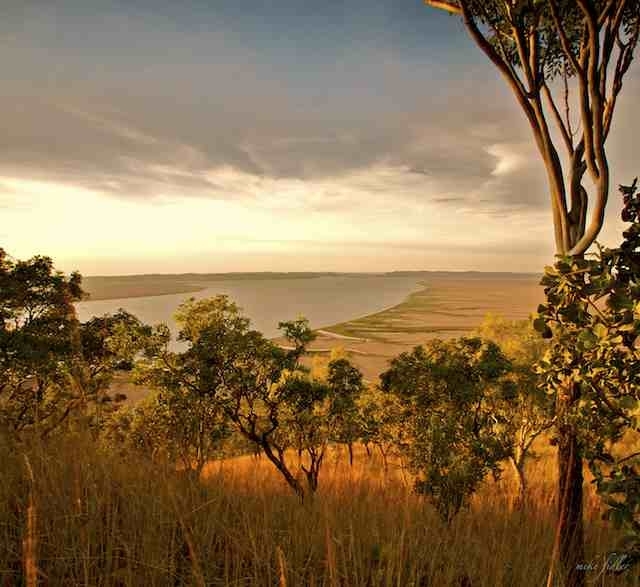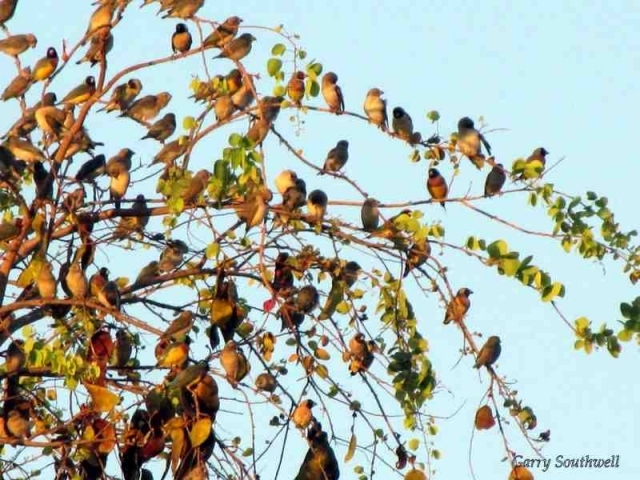Gouldian finch - Life in Nature
Distribution
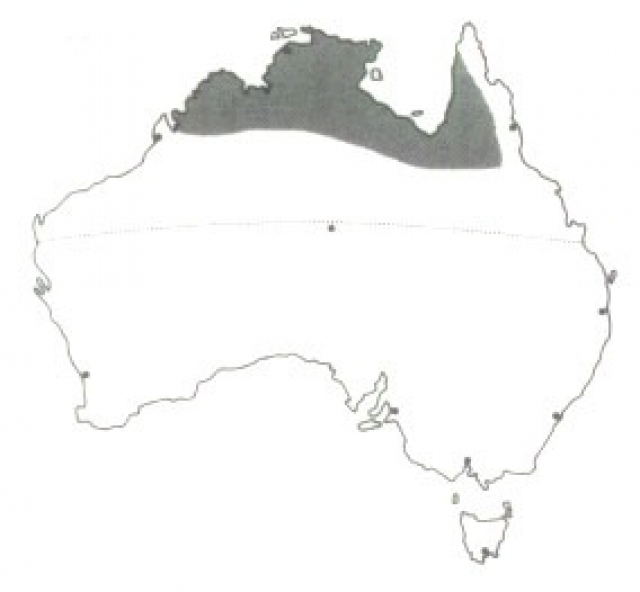 In the wild, these birds populate the northern part of the Australian continent; they live as far south as 19° southern latitude. For the survival of the population the number of landscape elements is very important, for example large areas of craggy hills with dense vegetation, including endemic grass undergrowth, characteristic for the natural nesting season biotopes of these birds. The lay of the land, not to mention natural barriers, such as rivers and streams, stop the spreading of wildfires and thus reduce their impact on the availability of food – grass seeds. The grassy undergrowth of the woodlands in the area of Gouldian Finch habitats provides a food source in times when seeds are scarce and throughout the wet season. The land, where these birds live is scarcely populated. Usually, it is a bright eucalypt savanna. Gouldian Finches avoid dense woods and they also do not live in the tropical forests of Cape York Peninsula.
In the wild, these birds populate the northern part of the Australian continent; they live as far south as 19° southern latitude. For the survival of the population the number of landscape elements is very important, for example large areas of craggy hills with dense vegetation, including endemic grass undergrowth, characteristic for the natural nesting season biotopes of these birds. The lay of the land, not to mention natural barriers, such as rivers and streams, stop the spreading of wildfires and thus reduce their impact on the availability of food – grass seeds. The grassy undergrowth of the woodlands in the area of Gouldian Finch habitats provides a food source in times when seeds are scarce and throughout the wet season. The land, where these birds live is scarcely populated. Usually, it is a bright eucalypt savanna. Gouldian Finches avoid dense woods and they also do not live in the tropical forests of Cape York Peninsula.
Biotope characteristic
 In the area populated by Gouldian Finches the maximum temperature goes over 40°C and even during wet season it stays as high as 30°C. The birds feel good in such conditions. Night temperatures vary, but rarely go under 20°C. In southern parts of their habitat, where the temperature is lower than in the north, it is 22°C on average. High temperatures are the reason, why these birds look for habitats with water sources.
In the area populated by Gouldian Finches the maximum temperature goes over 40°C and even during wet season it stays as high as 30°C. The birds feel good in such conditions. Night temperatures vary, but rarely go under 20°C. In southern parts of their habitat, where the temperature is lower than in the north, it is 22°C on average. High temperatures are the reason, why these birds look for habitats with water sources.
Species characteristic
 These birds drink by drawing water and drink a lot considering their weight. They need to drink every day, so viable water sources are a necessity. Shallow waterholes protected from predators are convenient. These birds avoid human housing; however they are quite social and form colonies.
These birds drink by drawing water and drink a lot considering their weight. They need to drink every day, so viable water sources are a necessity. Shallow waterholes protected from predators are convenient. These birds avoid human housing; however they are quite social and form colonies.
 Gouldian Finches have a more exclusive diet compared to other seed-feeding birds. They seek seeds of annual grasses (e.g. Sorghum, Vacoparis spp., bluestems - Schizachyrium spp.) which are available mainly during molting season and are a better source of nutrients than perennial grasses, such as Spinifex and grasses of the Kakadu region at the beginning of wet season.
Gouldian Finches have a more exclusive diet compared to other seed-feeding birds. They seek seeds of annual grasses (e.g. Sorghum, Vacoparis spp., bluestems - Schizachyrium spp.) which are available mainly during molting season and are a better source of nutrients than perennial grasses, such as Spinifex and grasses of the Kakadu region at the beginning of wet season.
 The presence of a large quantity of Eucalyptus – gum trees in these areas, such as the favored salmon gum or white gums growing further north, is a very important prerequisite for the availability of nesting cavities. These birds build their nests especially in cavities abandoned by parrots, mainly budgerigars or other cavity-nesting birds. Sometimes, nests built in tall grass or low thickets may be seen.
The presence of a large quantity of Eucalyptus – gum trees in these areas, such as the favored salmon gum or white gums growing further north, is a very important prerequisite for the availability of nesting cavities. These birds build their nests especially in cavities abandoned by parrots, mainly budgerigars or other cavity-nesting birds. Sometimes, nests built in tall grass or low thickets may be seen.
Due to developed social instincts and considering the deficiency of appropriate nests, it is possible to see more than one pair living in a single nest cavity and successfully raising their offspring there. For the population of Gouldian Finches in the wild the nesting season starts in the late wet season (March and April); the first raindrops stimulate the growth of seeds (Sorghum spp.), which are a highly nutritious food source. At this time, the production of sex hormones increases, which encourages mating and the birds start to seek nesting cavities. The beginning and the duration of their sexual activity overlaps with the period of high quality food source availability in their natural habitats. The following wet season, which brings plentiful harvest of seeds of the local kinds of grass, provides the independent offspring a reliable source of nourishment, for the time remaining until molting season.
The amount of rainfall and the length of wet season are different every year, so in Gouldian Finches we may also observe seasonal, so called opportunistic (adapted to certain conditions), nesting. During a dry year, the length of nesting season is shorter and it consists of one, at most two nestings. During a good year with a lot of rainfall, and a lot of food as well, nesting season may grow longer, which means up to three lays during nesting season. In the areas where the wild population lives, the night temperatures during nesting season average at 19°C and day temperatures average at 33°C.
Molting – species characteristic trait
In the wild it was sometimes possible to see a very early adolescence of young chicks. Under optimal conditions a 2-month old chick would finish molting and start nesting. The opposite occurs with the presence of high levels of stress. It is assumed that the critical period of physiological stress for the wild living population starts at the end of the dry season and the beginning of the wet season, as during the dry season sources of food can be very limited.
It seems that rapid molting is the result of evolutionary adaptation to the unpredictable climate and to the character of the environment of tropical forests, when molting of wings must have finished before the arrival of bad weather. It is necessary that molting happens quickly, so that the birds have enough time to move to places with enough food. But if unexpected events happen, such as cold weather or lack of food, it is better for them to interrupt molting and stay in the original youth feathers, which gives them better conditions for flight than feathers which are not fully grown. So the factor of environment plays a significant role in the process of molting. The night temperatures during molting season are usually 19°. When molting starts, when it is not so intensive, the temperatures reach 15° and are rising. During intensive molting the night temperatures go over 20° and day temperatures during this time move around 35°.
Rapid molting - impact on the population in the wild
The research by Milton Lewis shows that early finish of the molting process of the wings appears to be a very important fact, which is a condition for migration at the beginning of the wet season, when intensive rains make it even more difficult to find food. Researchers recorded the ability of rapid molting in Gouldian Finches, which is quite a remarkable trait. Milton Lewis (2001) reported molting, both in adults and in chicks, to last from September till November. Most wing feathers were replaced by the end of October and the molting process was complete by half of December. Tidemann and Woinarski (1994) reported that molting of wings ends in November.
Status of wild population
In the last decades a significant decrease of wild population was reported. The conservation status of Gouldian Finches changed to endangered in 1988, as their numbers in the wild have declined rapidly for more than two decades. As a result of these findings, the authorities of the Northern Territory have initiated the science research focused on finding the reasons behind this decrease of population. In Western Australia, Queensland and in the Northern Territory, Gouldian Finches are considered rare and endangered birds. In 2000 the estimated number of wild-living population was about 2500 nesting birds, the numbers obviously in decline. Research was at first focused on the documentation of breeding biology, population trends, the factor of diseases and the impact of fires on food sources.
This work showed that Gouldian Finches limited their food only to grass seeds and that the specific grass types were unevenly distributed in the wet season. Fires, grass grazing and a lot of rainfall significantly influenced grass seed production. More recent research verified Gouldian Finch behavior while locating food sources and the impact of the aggressive behavior of red-headed birds on the growth of the population.
Possible causes of wild population decline
Over the last forty-something years several possible causes of wild population decline were presented:
Trapping for commercial purposes (e.g. selling to breeders). Widespread use of bird traps lasted for nearly three decades, from 1960 to 1988, and thousands of Gouldian Finches were captured, dedicated for breeding purposes. Although trapping had such significant impact on the number of wild living Gouldians, the number could have grown in the following twenty years, because of the Gouldians’ ability to reproduce rapidly. This has not happened, however, and now the numbers of the remaining population are stable, but they are still at low levels. Currently, the wild living population consists of about 2500 birds.
 Changes in the technology of field burning have had serious impact on the growth of grasses, the seeds of which the Gouldians consume. It is assumed that this could be one of the main reasons why the numbers of Gouldian Finches haven’t grown even though trapping for commercial purposes has been illegal since 1988. It appears that the changes in original field burning practices during the last forty years bear the responsibility for the destruction or loss of substantial parts of grasslands, which had provided the wild-living population with a reliable food source. The traditional burning technique knowledge was lost, when cattle farms stopped employing aborigines, because based on the 1966 legislature, the aborigines were entitled to the same salary as working colonists. Until that time, the aborigines worked for food and accommodation and provided their traditional knowledge about field burning. The traditional methods of field burning – patch burning at low temperatures in the morning hours during late wet season or early dry season – disappeared with the aborigines. Traditional field burning had positive impact on the environment and it supported the regeneration of some perennial grass species, which are favored by the Gouldians and grow during wet season (e.g. Alloteropsis semialata - cockatoo grass, Triodia bitextura – curly spinifex). Non-traditional – before unused and more aggressive – field burning techniques were deliberately used with the intention to create very hot, uncontrolled fires, aimed to cleanse the land – including areas inhabited by Gouldians – of shrub vegetation and original grass species. These destructive fires speeded up the spreading of xeric (dry climate) grass species, such as buffelgrass (Pennisetum ciliare) used for livestock grazing. This also caused a decline of the population of the original species of grasses (such as Alloteropsis semialata - cockatoo grass, Chrysopogon fallax – ribbon / golden beard grass, Triodia bitextura – curly spinifex). These burning methods were so aggressive that it destroyed many natural nesting cavities. The traditional techniques of field burning (used by the aborigines) had positive impact on the quantity of seeds of cockatoo grass (Alloteropsis semialata) and the curly spinifex grass (Triodia bitextura), meaning that a complete exclusion of fires wouldn’t actually be beneficial.
Changes in the technology of field burning have had serious impact on the growth of grasses, the seeds of which the Gouldians consume. It is assumed that this could be one of the main reasons why the numbers of Gouldian Finches haven’t grown even though trapping for commercial purposes has been illegal since 1988. It appears that the changes in original field burning practices during the last forty years bear the responsibility for the destruction or loss of substantial parts of grasslands, which had provided the wild-living population with a reliable food source. The traditional burning technique knowledge was lost, when cattle farms stopped employing aborigines, because based on the 1966 legislature, the aborigines were entitled to the same salary as working colonists. Until that time, the aborigines worked for food and accommodation and provided their traditional knowledge about field burning. The traditional methods of field burning – patch burning at low temperatures in the morning hours during late wet season or early dry season – disappeared with the aborigines. Traditional field burning had positive impact on the environment and it supported the regeneration of some perennial grass species, which are favored by the Gouldians and grow during wet season (e.g. Alloteropsis semialata - cockatoo grass, Triodia bitextura – curly spinifex). Non-traditional – before unused and more aggressive – field burning techniques were deliberately used with the intention to create very hot, uncontrolled fires, aimed to cleanse the land – including areas inhabited by Gouldians – of shrub vegetation and original grass species. These destructive fires speeded up the spreading of xeric (dry climate) grass species, such as buffelgrass (Pennisetum ciliare) used for livestock grazing. This also caused a decline of the population of the original species of grasses (such as Alloteropsis semialata - cockatoo grass, Chrysopogon fallax – ribbon / golden beard grass, Triodia bitextura – curly spinifex). These burning methods were so aggressive that it destroyed many natural nesting cavities. The traditional techniques of field burning (used by the aborigines) had positive impact on the quantity of seeds of cockatoo grass (Alloteropsis semialata) and the curly spinifex grass (Triodia bitextura), meaning that a complete exclusion of fires wouldn’t actually be beneficial.
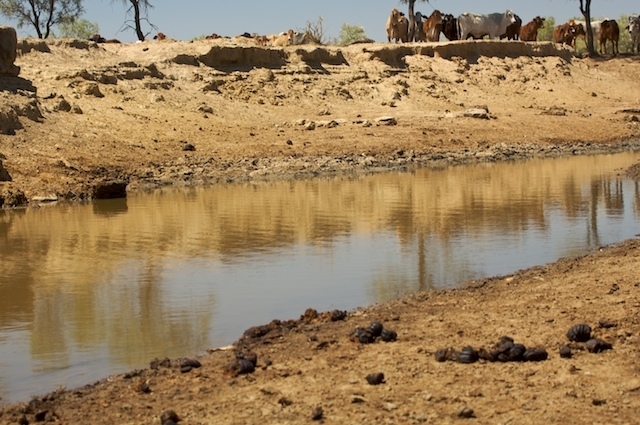 Another negative impact on the wild living Gouldians population comes from grazing of the native perennial grass species, which reduces the amount of seeds, which the Gouldians use as a food source during wet season.
Another negative impact on the wild living Gouldians population comes from grazing of the native perennial grass species, which reduces the amount of seeds, which the Gouldians use as a food source during wet season.
Regarding use of grassy areas for livestock grazing, fencing of significant grasslands has been recommended. However, as this might influence the productivity of the farm animals, this part – negotiations with the owners of the pastures – can be difficult. Currently, the protection of pastures lies in controlling wild-living herbivores. These measures are still insufficient, so development is necessary with respect to current knowledge about natural habitats, diet and food source location habits of the Gouldian Finches.
 Sternostoma tracheacolum mites: Mites in air sacs occur naturally (symbiotically) in Gouldian Finches and other Australian Estrildid birds. Distribution and intensity of infection are significantly greater in Gouldians than in other birds. A symbiotic relationship between the Gouldians and the Sternostoma tracheacolum mites probably exists in the wild-living population. In the wild-living Gouldian population critical mite infestation of the air sacs may occur, especially in cases of stress factor synergy. These happen especially in dry season, when the food sources are limited during the molting period. The Gouldians are able to eliminate these factors by ‘starting’ a later (slow) molting and thus limiting the adverse effects of mites living in their air sacs. Under these circumstances high mortality is improbable, as no sudden outbreaks of mites should occur, since the immune system of the birds is not overloaded by rapid molting.
Sternostoma tracheacolum mites: Mites in air sacs occur naturally (symbiotically) in Gouldian Finches and other Australian Estrildid birds. Distribution and intensity of infection are significantly greater in Gouldians than in other birds. A symbiotic relationship between the Gouldians and the Sternostoma tracheacolum mites probably exists in the wild-living population. In the wild-living Gouldian population critical mite infestation of the air sacs may occur, especially in cases of stress factor synergy. These happen especially in dry season, when the food sources are limited during the molting period. The Gouldians are able to eliminate these factors by ‘starting’ a later (slow) molting and thus limiting the adverse effects of mites living in their air sacs. Under these circumstances high mortality is improbable, as no sudden outbreaks of mites should occur, since the immune system of the birds is not overloaded by rapid molting.
Knowledge of ethology of the native population
Caring about the wild-living native Gouldian Finch population, including knowledge and protection of the original biotopes, where the Gouldians live, is one of the prerequisites to preserving the authentic genetic diversity and original species ethology. If we want the Gouldians to thrive in breeds, to prevent their diseases, instead of just treating them and to know their needs in captivity, it is first necessary to know the biotopes, where they live and where they have been phylogenetically formed, their ethology and all aspects of their life in their natural habitats.
Photographs from the wild are taken from the http://www.savethegouldian.org/ website, with the consent of Mr. M. Fidler.
Pieces of technical information on life in natural habitats were taken from an article by Dr. R. Marshall, published in 2009.
11.03.2014 -
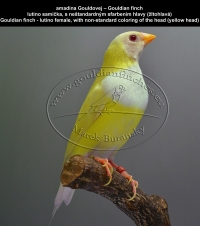
this website www.gouldianfinchces.eu
Contact:








